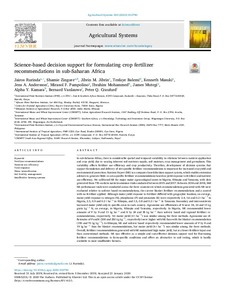| dc.contributor.author | Rurinda, J. |
| dc.contributor.author | Zingore, S. |
| dc.contributor.author | Jibrin, J.M. |
| dc.contributor.author | Balemi, T. |
| dc.contributor.author | Masuki, K. |
| dc.contributor.author | Andersson, J.A. |
| dc.contributor.author | Pampolino, M.F. |
| dc.contributor.author | Mohammed, I. |
| dc.contributor.author | Mutegi, J. |
| dc.contributor.author | Kamara, A.Y. |
| dc.contributor.author | Vanlauwe, B. |
| dc.contributor.author | Craufurd, P.Q. |
| dc.date.accessioned | 2020-06-02T11:37:18Z |
| dc.date.available | 2020-06-02T11:37:18Z |
| dc.date.issued | 2020-04 |
| dc.identifier.citation | Rurinda, J., Zingore, S., Jibrin, J.M., Balemi, T., Masuki, K., Andersson, J.A., ... & Craufurd, P.Q. (2020). Science-based decision support for formulating crop fertilizer recommendations in sub-Saharan Africa. Agricultural Systems, 180, 1-13. |
| dc.identifier.issn | 0308-521X |
| dc.identifier.uri | https://hdl.handle.net/20.500.12478/6853 |
| dc.description.abstract | In sub-Saharan Africa, there is considerable spatial and temporal variability in relations between nutrient application and crop yield, due to varying inherent soil nutrients supply, soil moisture, crop management and germplasm. This variability affects fertilizer use efficiency and crop productivity. Therefore, development of decision systems that support formulation and delivery of site-specific fertilizer recommendations is important for increased crop yield and environmental protection. Nutrient Expert (NE) is a computer-based decision support system, which enables extension advisers to generate field- or area-specific fertilizer recommendations based on yield response to fertilizer and nutrient use efficiency. We calibrated NE for major maize agroecological zones in Nigeria, Ethiopia and Tanzania, with data generated from 735 on-farm nutrient omission trials conducted between 2015 and 2017. Between 2016 and 2018, 368 NE performance trials were conducted across the three countries in which recommendations generated with NE were evaluated relative to soil-test based recommendations, the current blanket fertilizer recommendations and a control with no fertilizer applied. Although maize yield response to fertilizer differed with geographic location; on average, maize yield response to nitrogen (N), phosphorus (P) and potassium (K) were respectively 2.4, 1.6 and 0.2 t ha−1 in Nigeria, 2.3, 0.9 and 0.2 t ha−1 in Ethiopia, and 1.5, 0.8 and 0.2 t ha−1 in Tanzania. Secondary and micronutrients increased maize yield only in specific areas in each country. Agronomic use efficiencies of N were 18, 22 and 13 kg grain kg−1 N, on average, in Nigeria, Ethiopia and Tanzania, respectively. In Nigeria, NE recommended lower amounts of P by 9 and 11 kg ha−1 and K by 24 and 38 kg ha−1 than soil-test based and regional fertilizer recommendations, respectively. Yet maize yield (4 t ha−1) was similar among the three methods. Agronomic use efficiencies of P and K (300 and 250 kg kg−1, respectively) were higher with NE than with the blanket recommendation (150 and 70 kg kg−1). In Ethiopia, NE and soil-test based respectively recommended lower amounts of P by 8 and 19 kg ha−1 than the blanket recommendations, but maize yield (6 t ha−1) was similar among the three methods. Overall, fertilizer recommendations generated with NE maintained high maize yield, but at a lower fertilizer input cost than conventional methods. NE was effective as a simple and cost-effective decision support tool for fine-tuning fertilizer recommendations to farm-specific conditions and offers an alternative to soil testing, which is hardly available to most smallholder farmers. |
| dc.description.sponsorship | Bill & Melinda Gates Foundation |
| dc.format.extent | 1-13 |
| dc.language.iso | en |
| dc.subject | Fertilizers |
| dc.subject | Nutrients |
| dc.subject | Yields |
| dc.subject | Maize |
| dc.subject | Intensification |
| dc.subject | Soil Fertility |
| dc.subject | Smallholders |
| dc.subject | Farming Systems |
| dc.subject | Subsaharan Africa |
| dc.subject | Fertilizer Application |
| dc.title | Science-based decision support for formulating crop fertilizer recommendations in sub-Saharan Africa |
| dc.type | Journal Article |
| cg.contributor.crp | Maize |
| cg.contributor.crp | Roots, Tubers and Bananas |
| cg.contributor.affiliation | International Plant Nutrition Institute |
| cg.contributor.affiliation | African Plant Nutrition Institute |
| cg.contributor.affiliation | Bayero University Kano |
| cg.contributor.affiliation | Ethiopian Institute of Agricultural Research |
| cg.contributor.affiliation | International Maize and Wheat Improvement Center |
| cg.contributor.affiliation | International Institute of Tropical Agriculture |
| cg.coverage.region | Africa |
| cg.coverage.region | East Africa |
| cg.coverage.region | West Africa |
| cg.coverage.country | Ethiopia |
| cg.coverage.country | Nigeria |
| cg.coverage.country | Tanzania |
| cg.coverage.hub | Eastern Africa Hub |
| cg.coverage.hub | Headquarters and Western Africa Hub |
| cg.researchtheme | Natural Resource Management |
| cg.researchtheme | Plant Production and Health |
| cg.identifier.bibtexciteid | RURINDA:2020 |
| cg.isijournal | ISI Journal |
| cg.authorship.types | CGIAR and developing country institute |
| cg.iitasubject | Agronomy |
| cg.iitasubject | Food Security |
| cg.iitasubject | Food Systems |
| cg.iitasubject | Integrated Soil Fertility Management |
| cg.iitasubject | Plant Breeding |
| cg.iitasubject | Plant Production |
| cg.iitasubject | Smallholder Farmers |
| cg.iitasubject | Soil Fertility |
| cg.journal | Agricultural Systems |
| cg.notes | Open Access Journal; Published online: 31 Jan 2020 |
| cg.accessibilitystatus | Open Access |
| cg.reviewstatus | Peer Review |
| cg.usagerightslicense | Creative Commons Attribution 4.0 (CC BY 0.0) |
| cg.targetaudience | Scientists |
| cg.identifier.doi | https://dx.doi.org/10.1016/j.agsy.2020.102790 |
| cg.iitaauthor.identifier | Ibrahim Mohammed: 0000-0001-5199-5528 |
| cg.iitaauthor.identifier | Alpha Kamara: 0000-0002-1844-2574 |
| cg.iitaauthor.identifier | bernard vanlauwe: 0000-0001-6016-6027 |

